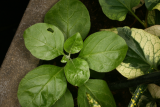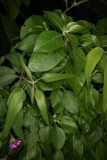Additional notes (click to expand)
Commemorative
In Flora of Australia (Purdie et al. 1982:184) it is stated that the genus Withania is named after Henry Witham (sic.), an English palaeobotanist of the early 19th century.
www.plantzafrica.com
Named for Henry Thomas Maire Witham (name at birth = Silvertop), 1779-1844 of Northumberland. Paleobotanist. Wrote 'Observations on fossil vegetables.'
Desmond, Ray. (1977). Dictionary of British and Irish Botanists and Horticulturists. Taylor and Francis, London.
Medicinal
Medicinal uses
Uses supported by clinical data
As an antistress agent to improve reaction time (15).
Uses described in pharmacopoeias and well established documents
As a general tonic to increase energy, improve overall health and prevent
disease in athletes and the elderly (1, 16).
Uses described in traditional medicine
Treatment of bronchitis, dyspepsia, impotency, scabies and ulcers (5, 16).
Contraindications
Due to the lack of safety data and the fact that the crude drug has been
used in traditional medicine to induce abortion, its use during pregnancy
or breastfeeding is contraindicated (4).
From WHO Monographs on Selected Medicinal Plants Vol 4 2005, WHO Geneva
Long employed in Ayuverdic medicine in India. Its composition and the wide claims for therapeutic activity in many diseases, including cancer and stress, are reviewed in Tewari et al 2022.
Withania somnifera (L.) Dunal: Phytochemistry, structure-activity relationship, and anticancer potential. Phytomedicine 98, 153949.
Toxicity
A member of the Solanaceae family but with only a low level of tropane alkaloids. Its content of steroidal lactones, the withanolides, steroidal lactones, may be responsible for the effects of a large dose in causing headache, diarrhoea, sedation and nausea, as well as the numerous claimed beneficial actions.
Rakesh, M., Akanksha, J. 2010. Chemistry and pharmacology of Withania coagulans: an Ayurvedic remedy, J Pharm Pharmacol. 62 153–160.
Geographical distribution
- Africa, Macaronesia, Cape Verde
- Africa, Northeast Tropical Africa
- Africa, Northern Africa
- Africa, South Tropical Africa
- Africa, Southern Africa
- Africa, West Tropical Africa
- Africa, Western Indian Ocean
- Asia-Temperate, Arabian Peninsula
- Asia-Temperate, Western Asia
- Asia-Tropical, Indian Subcontinent, India
- Asia-Tropical, Indian Subcontinent, Pakistan
- Asia-Tropical, Indian Subcontinent, Sri Lanka
- Europe, Southeastern Europe, Greece
- Europe, Southeastern Europe, Italy
- Europe, Southeastern Europe, Sicilia
- Europe, Southwestern Europe, Sardegna
- Europe, Southwestern Europe, Spain
Withania somnifera (L.) Dunal
Family: SOLANACEAEGenus: Withania
Species: somnifera (L.) Dunal
Common names: Ashwagandha; Winter-Cherry; Indian Ginseng
Distribution summary: Africa, Asia, S.Europe
Habit: Perennial
Hardiness: H2 - Tender; cool or frost-free greenhouse
Habitat: Stream banks, scrub and waste or disturbed ground
Garden status: Currently grown
Garden location: Plants in pots (POT), Olive tree bed (O)
Reason for growing: Medicinal, toxic

